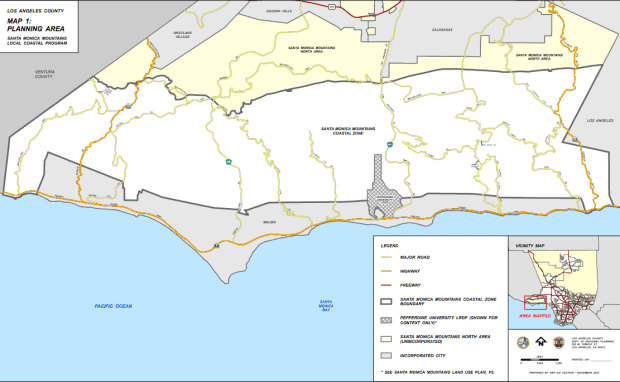
Responding to an overwhelming number of questions from the equestrian community about the Santa Monica Mountains Local Coastal Plan (LCP), LA County staffers met with nearly 100 people at a Monte Nido home last Friday in an attempt to allay fears.
The County Board of Supervisors approved the LCP on February 11, and the plan is due before the California Coastal Commission (CCC) on April 10. Because the public was given eight weeks to review the 800-page document, the equestrian community asked the county to lead the Q&A.
The plan covers the unincorporated areas of the Santa Monica Mountains within the “Coastal Zone” and in Los Angeles County—an area of about 80 square miles.
Although initially approved by the county in 2007, officials spent another seven years making changes to get more buy-in from stakeholders like environmental organizations, government agencies and homeowners.
Since the plan’s release, the equestrian community has voiced its concern over the possibility of not being able to keep horses in residential yards, and Friday’s line of questioning dealt heavily with the specifics of horse ownership.
Representing the county at the meeting was Ben Saltsman, LCP co-author and planning deputy for Supervisor Zev Yaroslavsky, Richard Bruckner, chief planner for the county, and Andi Culbertson, county consultant and lobbyist to the CCC.
They stressed that equestrians would be much better off with the proposed LCP since the county has worked closely with the powerful coastal body to assure that local horse-owners maintain their rights.
“We wrote it deliberately with the people in mind who are facing threats from the CCC in order that you can keep your horses and maintain the rural quality of life,” Saltsman said. “The CCC has not historically been so friendly to horses as this plan.”
The CCC has made “huge concessions” on horses in exchange for various conservation programs from the county,” Saltsman said.
“This will be the only area in the county where horses are permitted in backyards,” he added.
Under the plan, residents will still be allowed a maximum of eight horses per acre; however, specific sites will need to have their vegetation, terrain and water sources analyzed on a case-by-case basis to determine how many horses can be on that property.
Many of the night’s questions were technical, with residents asking about barn lighting, how to appeal something to the CCC if the county does not approve it, calculation of water standby charges from the Las Virgenes Water District for unused acreage, how the CCC will interpret contradictions within the LCP, drainage issues and permit fees.
“This LCP allows more gardens, etc., than the California Coastal Commission does today. And if you don’t have all of your buildings permitted, you’ll have a better chance of getting permits approved with the LCP… The new LCP will also allow 12 times more space for horses,” Saltsman said.
Most of the equestrian community was on board with the county by the end of the session, with only a few still voicing opposition.
When asked why the county never took the LCP to the CCC for approval back in 2007, Saltsman said that after the Board of Supervisors approved it, “Zev got a call from Peter Douglas [then-head of the CCC], who said, ‘Your plan is dead in the water.’ So we took time out and sat down with them again over the past two years …They’ve come a long way, and we appreciate that.”
“It’s better to have local control and real rules here,” Bruckner added. “We’ve pushed the envelope, this LCP is different than any other LCP plan that’s ever been done.”
A number of residents wanted to know what they could do to support the LCP when it goes before the CCC for approval on Thursday, Apr. 10 in Santa Barbara.
“You should come [to Santa Barbara, sign up for public comment] and say you like horses and you like riding, because other groups will be there to oppose it based on water quality, habitat, etc.,” Culbertson said. “And if you don’t like the suggested modifications, tell the CCC.”


